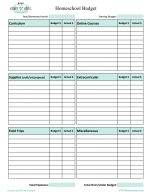
013.
Homeschooling on a Budget
Can I afford to homeschool?
What do I need to buy to homeschool?
How much does curricula cost?
Tune in this week while we discuss these topics and more!
Episode 013:
TWO WAYS TO LISTEN TO THIS EPISODE:
1. Click PLAY Button Above ^^ to listen here.
2. OR Listen on your favorite podcast platform:
Scroll Down for this Week’s Freebie
Brand New to Homeschooling?
GETTING START PAGE >>
Kindergarten Page >>
High School Series >>
Show Notes
The holidays are over and we once again overspent even though we said we wouldn’t, and now it’s the new year. We are all fresh off our downward holiday spiral and riding that new year motivational high. So let’s start the year financially savvy. If you haven’t already, creating a household budget in general with line items for things like homeschool supplies, memberships, educational classes, and activities/travel can help you stay on track.
Can I afford to homeschool? (3:06)
Real life is messy, no matter how your family looks. Home education is as diverse as the families involved! The beauty of homeschooling is the flexibility—it can fit any individual, lifestyle, or family type.
Whether you are dual income,single income, or single parenting, most of us probably need to be mindful of whether we can actually afford to homeschool. Sometimes it is simply not going to be realistic for this season of your life, and that’s ok. We’ve discussed some other options to having your child at home that aren’t necessarily homeschooling in our “Getting Started” episode. But if you can, let’s talk about some ways to make homeschooling work in your home! Just keep in mind that a low-cost education does not mean a substandard one!
Even if you’re not a single parent, Oftentimes, this is going to involve a shift to a single income. So how can you continue to provide for your family and school your children at home? Working from home would be the ideal situation. If possible, pursue bringing your job home. Perhaps your boss is open to you working remotely, at least maybe part-time. Since the pandemic, this has become more and more common.
You may need to do some juggling while you try to balance schooling with different work schedules. One fantastic aspect of homeschooling is that you can do it anytime, from anywhere. Evaluate your family— age, temperament, etc. Can they go to the office/worksite with you? Maybe there’s another family member who can stay with the kids while you work? Could you do school in the evenings and on the weekends? We discussed in our episode about homeschool styles and philosophies that possibly your child may perform better doing school at a different time than a traditional schedule. You may find that it works for you to hire a nanny or do independent or online schooling? You may have to think outside the box, but that’s what home education is all about!
The good news is homeschooling does not have to be expensive and there are lots of ways to save money, supplement a single income, and school on a budget.
Envelope Budgeting System

Making a very strict budget is one way to be successful. And one of the ways we found to stick to a budget was through an envelope system. Although it’s not a secular financial program, we used an envelope system program suggested by Dave Ramsey. It’s a really practical way to budget and when you’re using a cash system, you cannot overspend, and it’s really important for your children to see the money move.
Ways to save money while homeschooling:
- Making all your meals at home/packing lunches/ menu planning
- Shopping dollar stores/dollar bins at Target
- Garage sales
- Thrift stores
- Shopping discounts
- Hand me downs
- Gift lists for family- memberships, educational toys, games
Ways to supplement a single income or make money from home:
- Work from home- build a business
- Pet sitting
- Babysitting
- Blogging
- Picking up kids from school and dropping them off at home or after school program
- Online tutor
- Music lessons
- Refurbish furniture
- Work from home- selling
- Sell online-eBay, Amazon, Facebook marketplace
- Sell other people’s stuff
- Sell at farmers markets -vegetables or crafts
- Start Etsy shop
- Dropshipping
- Work from home-online jobs
- Teach international students English
- Virtual assistant
- Freelance writer
- Virtual Customer service, reservations
- Gig work-Door dash, GrubHub, Instacart, Shipt
- Usborne books
- Surveys or Studies
- Secret shopper/studies with UT southwestern, Curion, kid studies
What do I need to buy to homeschool? (13:39)
There are definitely things you want when homeschooling and then the things that you actually need. You do not need a fabulous Pinterest homeschooling classroom with tons of bookshelves and fancy desks, computers, and beautiful framed inspirational education posters. Even if you do have that, often your kids are going to want to slump on the sofa or their bed with a pile of library books. Don’t overcomplicate things.
Homeschooling necessities- what do you really need
- Consumable items- paper, pens, markers, crayons, pencils
- Extra-curriculars- not really necessary, but for a low cost option, you may want to consider rec center, pooling resources with another parent, or a non academic co-op – check all our suggestions below!)
- Equipment- microscopes, books, project supplies
A great way to get supplies is by attending Curriculum swaps, retiring homeschooler sale, Ebay, Facebook marketplace, and Facebook homeschool sale groups. You may also check if your town has a homeschool store- we have one in north Texas and they even offer used curricula at a discount. We would also say that once you’re done with curriculum and you’re not going to use it for consecutive children, sell it as soon as possible. It will hold its value better before newer updates are created. A homeschool group we were in for years, had a lending library with curriculum and supplies, including a microscope. Totally free!
If you have multiple kids, you may want to choose reproducible resources. Or you can make your own reproducible resources (laminating pages and dry erase markers.) You may want to consider a really good printer or use Office Depot specials to print. For example, with SOTW, someone turned us on to having Office Depot cut the binding and then having the activity pages spiral bound, while we had the consumable worksheets 3 hole punched. This allowed the same set to be used for multiple children, and then pass it on to another family afterward.
Be sure to check with your curriculum to make sure this is actually allowed. Many will have information on that publishing page and you do want to be mindful of copyright rules. It’s also important to remember that many homeschool curriculum providers are homeschooling parents, as well, and this is their side business that has allowed them to afford homeschooling. Please be sure to be ethical in your sharing of resources.
How much does curricula cost? (17:31)
There are a ton of free and cheap resources out there, but curricula can also be really expensive. Again, one of the first things to do when selecting something, is to make sure you know your homeschool style and worldview. It may not be worth it to use a completely free curriculum if it doesn’t align with your family’s belief system or is otherwise problematic.
And If you’re not completely sure, that’s ok! Just check out episode 4 where we walk you through identifying your homeschool philosophy and worldview. In the show notes on our website, we provided some great information and resources to help you uncover the worldview hidden in curriculum.
Another tip is to refrain from buying more than a year in advance. It may be tempting when you see some mom selling 5 years of Saxon math on Facebook marketplace to just snap it all up, but that’s not a great idea unless you know for sure that that program is still going to work for your child down the line. We recommend purchasing for the next year, sell when done, and roll that into the next year.
One thing to look into with older students is Clep testing or Dual Credit. Many times these are offered free or at a discount and can be used for college credit. This can save an enormous amount of time and money long term. We’ve mentioned our local community college offers free or discounted dual credit classes and this was a fabulous resource for us both.
Look into group buys with sites like Homeschoolers Buyers Club -they also have a lot of free resources, and you can also get free homeschool ids here-we download them every year for the first day of school! They often pool resources to get programs that are otherwise financially out of reach or only available to schools or groups with huge numbers of students.
You can make your own curriculum. From writing it yourself, or using resources like Pinterest, blogs, homeschool Instagram, YouTube, sites like Enchanted Learning, 123Homeschool4me, homeschool share, or Teachers Pay Teachers. These may require a membership fee but then allow you access to tons of resources.
You can look at publisher’s websites for resources or supplemental material, too. Sites for book or book series like Magic Tree House had a downloadable passport, quizzes, and all kinds of lesson plans and printables that went with each book. It was such an easy way to make an entire class work on the fly. And there are several books in this series, readily available at the library or second hand, too.

There are so many great apps or online educational streaming resources. Sometimes you can access passwords from local school districts (or just by googling)- we used Brain Pop this way for many years. Discovery streaming is also popular. We LOVED Reading eggs and Starfall. Before buying, Look for free trials to check things out to see if they will work for your family.
The encyclopedia is also awesome and available free online. Using Libby/Overdrive through your local library or in conjunction with Broward County or NYC library systems allows you unlimited audio/digital book options. Your library can also be a resource for free passes, language classes.
There are also thousands of books available on the public domain and they are available as Ebooks and Audiobooks. Loyal Books.com is a fantastic website and easy to search titles
Scratch is a fantastic free program produced by MIT to teach young children how to code. There’s tons of free YouTube videos, and books you can check out step you through learning. Our kids started there and eventually programmed a raspberry pie before building their first computer. Also we love John and Hank Greene’s Crash course video series on YouTube. Really, just anything YouTube! What a great free resource!
Khan Academy is a fabulous free website that offers free programming. It’s great for entire classes or sometimes we may use it to look up videos for things, like math concepts, that we may need additional help with.
We’ve talked at length about co-ops and otherwise pooling resources with other parents. This can be a huge money and time saver, while also offering a wonderful social outlet for your kids. Along with this, you could also try bartering tutoring with a friend or acquaintance or volunteering your time with another group in exchange for classes or access to resources.
Another way to save money on curricula and supplies is to shop sales. Many curriculum companies have sales multiple times a year. Be on the lookout for those and plan ahead. You can also look at office supply rebates, or using teacher discounts, and piggybacking on back to school sales or tax free weekends.
Printing out your own teacher ID can net you some teachers discounts. These are available at Barnes and Noble, Half Price Books, Joanns, etc. You can print your a free ID at Homeschool Buyers Club
Scholastic book warehouses are located in several cities and offer huge sales a couple times a year. You can register as a homeschool teacher and show up and save money on classroom items.
We also don’t want to forget activities and extra curriculars! And just because you are on a strict budget does not mean you have to pass these things up. There are so many cheap and free educational resources out there.
For one, you can look at sites like Groupon, Citipass, or Pogo Pass for discounts to area attractions or activities. One year, several of us bought Pogo Passes and met up together at various places. They may have museum entry, or go-carting, or waterpark tickets included. Also, it’s important to know that you can always create your own extracurricular and invite friends! Do you know tennis? Teach a group tennis class! Do you know art? Teach an art group. People are always willing to participate when you’re the one organizing. Pick something that your child has a strong interest in and just do it.Lego club? Book club? Gardening? The possibilities are endless!
Museum family memberships can be a great value if they are a place you visit more than once or twice. Oftentimes a membership pays for itself in just a couple visits. These are also great gifts to ask for from extended family. Many also partner with reciprocal programs.
There is a science museum program (Association of Science and Technology Centers) and an arboretum program (American Horticultural Society). These are great locally and can be really handy when traveling out of town or planning a family vacation.
If you have access to any State or National Parks nearby, these are a fantastic resource for education. Many have Junior Ranger programs that are free to access, sometimes you can even do these online without physically visiting a park. Amtrak also partners with the NPS in the summer and offers programming onboard trains. The Every Kid Outdoors Program gives all 4th graders a free National Parks Pass. This pass allows access for all children under 16 in the group and up to three accompanying adults (or an entire car for drive-in parks) to most federally managed lands and waters.
You should also look at local historical sites and places. Many areas may have local villages, farmsteads or other sites that offer demonstrations, or self-guided/guided tours. These are often free or very low cost ($5) but may require advanced reservations.
Look at your local museums. Many offer programming sometimes just for homeschoolers. Some may also have homeschool days- our zoo and science museums do that as well and it’s a great way to spend a day exploring!
For the arts, you can often find free or low-cost community concerts, or student matinee shows. For several years we attended our local Opera House’s dress rehearsals for shows. These were totally free and typically the full show without interruption!
Check out your local community or rec center for classes, field trips, sports opportunities. This is a great way to try out an activity with a short commitment or join a specific art or dance class at a great price. Just having a membership to your local rec center can be a huge value for access to a gym, pool, courts and other rec activities.
Field trips are often a great way to get free or discounted entry. Our local Aquarium never has coupons available but you can get a significant discount if you book as a group. Often, if you are the organizer, you get your entrance for free! Some government sites are open to the public or offer free tours- the Federal Reserve and US MInt are two, you can also typically tour your state capital this way. Consider this when traveling (Washington DC has the BEST museums, and they are all free to enter.)

We’ve given you so many tips and ways to save and budget. But honestly, homeschooling does not have to be complicated! Sometimes less is more and it’s important to remember that this is not a race and it’s OK to minimize all of the things. You’re here for the experiences so stay in the moment and teach your children to appreciate and value what they do have.








